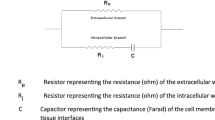Abstract
The emergence of superoxide anion radicals (O2-) in the guinea pig inner ear following acoustic trauma was investigated by histochemical methods. Five minutes after exposure to sound at 120–125 dB SPL for 3 h, an O2- reaction product was detected in the cochlea along the luminal membrane of the marginal cells of the stria vascularis. This reaction product could not be found at 30 min, but reappeared at 2 h. The first appearance of O2- is not explainable by our studies, but the second appearance may be related to recirculation of strial blood flow after blood flow stasis. The present observations raise the possibility that free radicals are produced in the inner ear after acoustic trauma and lead to inner ear damage.
Similar content being viewed by others
References
Axelsson A, Dengerink K (1987) The effect of noise on histological measures of cochlear vasculature and red blood cell: a review. Hear Res 31:183–192
Briggs RT, Robinson JM, Karnovsky ML, Karnovsky MJ (1986) Superoxide production by polymorphonuclear leukocytes. A cytochemical approach. Histochemistry 84:371–378
Cross CE, Halliwell B, Borish ET, Pryor WA, Ames BN, Saul RL, McCord JM, Harman D (1987) Oxygen radicals and human disease. Ann Intern Med 107:526–545
Granger DN (1988) Role of xanthine oxidase and granulocytes in ischemia-reperfusion injury. Am J Physiol 255:H1269-H1275
Granger DN, Rutili G, McCord JM (1981) Superoxide radicals in feline intestinal ischemia. Gastroenterology 81:22–29
Hultcrantz E (1979) The effect of noise on cochlear blood flow in the conscious rabbit. Acta Physiol Scand 106:29–37
Kurosawa K, Shibata H, Hayashi N, Sato N, Kamada T, Tagawa K (1990) Kinetics of hydroperoxide degradation by NADP-glutachion system in mitochondria. J Biochem 108:9–16
Ohno Y, Hirai K, Kanoh T, Uchino H, Ogawa K (1982) Subcellular localization of H202 production in human neutrophils stimulated with particles and an effect of cytochalasin-B on the cells. Blood 60:253–260
Okada H, Yamane H, Nakai Y (1991) Morphological changes of the spiral vessel after rock music exposure. Acta Otolaryngol (Stockh) [Suppl] 486:61–65
Prazma J, Rodgers GK, Pillsbury HC (1983) Cochlear blood flow: effect of noise. Arch Otolaryngol 109:611–615
Scott VD, Love G (1983) Quantitative electron-probe microanalysis. Ellis Horwood, West Sussex, England
Throne PR, Nuttal AL (1987) Laser Doppler measurements of cochlear blood flow during loud sound exposure in the guinea pig. Hear Res 27:1–10
Turrens JF, Alexandre A, Lehninger AL (1985) Ubisemiquinone is the electron donor for superoxide formation by complex III of heart mitochondria. Arch Biochem Biophys 237:408–414
Yamane H, Nakai Y, Konishi K, Sakamoto H, Matsuda Y, Iguchi H (1991) Strial circulation impairment due to acoustic trauma. Acta Otolaryngol (Stockh) 111:85–93
Author information
Authors and Affiliations
Rights and permissions
About this article
Cite this article
Yamane, H., Nakai, Y., Takayama, M. et al. Appearance of free radicals in the guinea pig inner ear after noise-induced acoustic trauma. Eur Arch Otorhinolaryngol 252, 504–508 (1995). https://doi.org/10.1007/BF02114761
Received:
Accepted:
Issue Date:
DOI: https://doi.org/10.1007/BF02114761




